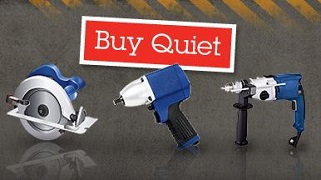Buy Quiet – Background

Background
Buy Quiet is an occupational health and safety prevention initiative which encourages companies to purchase or rent quieter machinery when new businesses start or as older machinery is replaced in order to reduce worker exposure to noise. NIOSH has developed material to assist companies and promote the implementation of Buy Quiet programs. NIOSH’s Buy Quiet effort is part of the broader Hearing Loss Prevention Program, which conducts research on the causes of occupational hearing loss and works to deliver practical prevention solutions to employers. Buy Quiet is also a specific application of a broader NIOSH initiative – Prevention through Design (PtD). The PtD initiative seeks to prevent or reduce occupational injuries, illnesses, and fatalities through the inclusion of prevention considerations in all designs that impact workers. Buy Quiet addresses this vision by eliminating noise hazards early in the life cycle of equipment and machinery, thus reducing the risk of occupational hearing loss among workers who use these tools.
Thousands of pieces of noise-producing machinery and equipment are used in U.S. industries. While noise control is necessary to protect workers from hearing loss in those industries, many companies do not have the financial resources or technical expertise to retrofit engineering controls for noise on equipment and machinery currently in use. Furthermore, quieting equipment during design and fabrication is more effective and economically-efficient than implementing noise controls after manufacture. Buy Quiet assigns the engineering decisions to the equipment designers and manufacturers and removes the complexity of noise control from the purchaser, renter or end user whose core business is not noise control. Concurrent with protecting worker’s hearing health, the Buy Quiet initiative aims to remove workers from legally mandated hearing conservation programs by reducing noise exposures to below 85 decibels (dBA) for 8 hours. Hearing conservation programs incur costs associated with providing annual audiograms with follow-up to their employees, providing those employees appropriate hearing protection, accomplishing noise surveys in the workplace, and maintaining the appropriate recordkeeping to describe those activities. These hearing conservation programs are not as successful at protecting hearing health as noise reduction based programs.

While Buy Quiet is simple in concept, the tools necessary to implement it have been lacking. Noise level data for specific pieces of equipment or machinery have not been readily available for business owners and those purchasing equipment and machinery. Equipment manufacturers do not have a defined procedure in the U.S. for providing noise level data to consumers, and equipment purchasers do not have a centralized location where they can find these data. To solve these problems, NIOSH has led efforts to promote Buy Quiet initiatives and to encourage companies to implement Buy Quiet programs within their organization. Any company whose workers are subjected to hazardous noise exposures can benefit from Buy Quiet.

